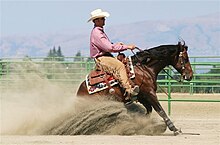Reining

A competitor performing the sliding stop, one of the signature moves of a reining horse
|
|
| Highest governing body | International Federation for Equestrian Sports (FEI) |
|---|---|
| First played | United States |
| Characteristics | |
| Contact | no |
| Team members | individual and team at international levels |
| Mixed gender | yes |
| Type | indoor or outdoor |
| Equipment | horse, western saddle and related horse tack |
| Venue | Arena indoor or outdoor with dirt or similar footing suitable for the horse |
| Presence | |
| Country or region | Worldwide |
Reining is a western riding competition for horses where the riders guide the horses through a precise pattern of circles, spins, and stops. All work is done at the lope (a slow, relaxed version of the horse gait more commonly known worldwide as the canter), or the gallop (the fastest of the horse gaits). Originating from working cattle, reining is often described as a Western form of dressage riding, as it requires the horse to be responsive and in tune with its rider, whose aids should not be easily seen, and judges the horse on its ability to perform a set pattern of movements. The horse should be willingly guided or controlled with little or no apparent resistance and dictated to completely. A horse that pins his ears, conveying a threat to his rider, refuses to go forward, runs sideways, bounces his rear, wrings his tail in irritation or displays an overall poor attitude is not being guided willingly, and is judged accordingly.
Throughout the history of the Americas, dating back to the earliest Spanish settlers in what today is Mexico and the Southwestern United States, including Texas and California, ranchers needed to manage cattle from horseback. Cattle were moved, , doctored, sorted, and herded, often on open range without the benefit of fences, barns or other means of holding the animals. A good cowboy needed a quick and nimble horse, one that could change directions quickly, stop "on a dime," and sprint after an errant cow. The horse needed to be controlled mostly by legs and weight, ridden with only one hand and a light touch on the reins, so that the cowboy's attention could also be on tasks that could include handling a lariat (to rope cattle), opening a gate, or simply waving a hand, hat or rope to move along a reluctant herd animal. Informal demonstrations of these ideal characteristics amongst ranch cowboys and vaqueros evolved into the sport of reining, as well as the related events of cutting and working cow horse as well as several other horse show classes.
...
Wikipedia
